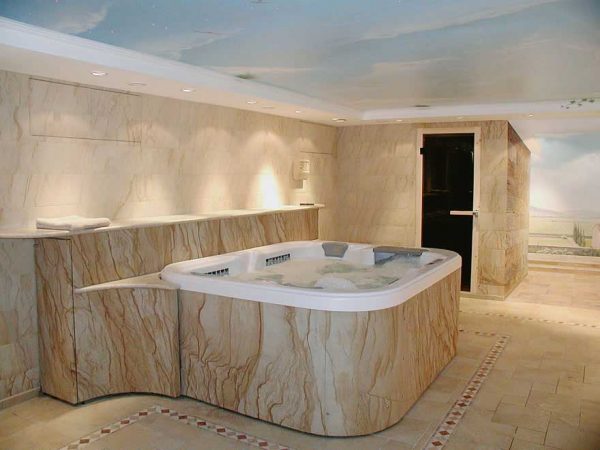Flexible stone is a new generation of material, natural and environmentally friendly, safe for humans. It is a thin section of natural stone and is used for decorating walls in rooms, decorating doors and windows, and is even suitable for facing facades.
- Flexible Stone Production Technology
- Material scope
- Advantages and disadvantages of the material
- Material Specifications
- Features and operational characteristics of the material by type
- Flexible stone in the form of stone wallpaper
- Tile flexible stone
- Flexible stone thermal panels
- Features of manufacturing flexible stone
- Flexible stone mounting technology: features and nuances
- Foundation preparation
- Selection and application of adhesive for flexible stone
- Installation of finishing material
- Errors in the design of premises
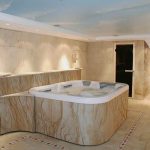
Due to the mass of positive properties, the material is rapidly gaining popularity among builders and users.
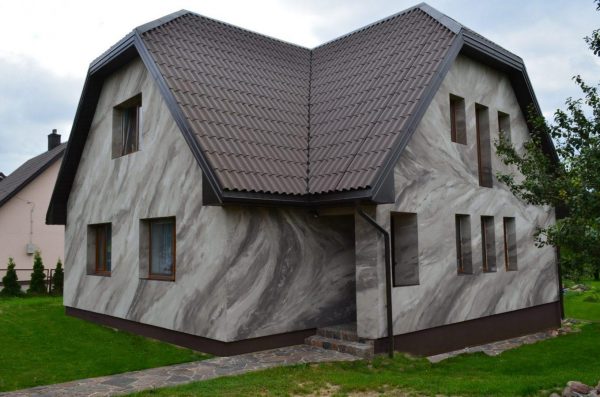
Flexible Stone Production Technology
Flexible stone production began just 20 years ago in Germany. Now this material competes with tiles, natural stone and various types of artificial finishes. Product release is carried out in a combined way - automatically and manually, based on sandstone: a natural mineral, sedimentary rock.
Flexible stone is produced right at the place of extraction of sandstone. After collecting the mineral from the quarry, specialists select suitable samples, taking into account the slice pattern, color and texture of the base. The raw materials are finely cut, polished to smooth out irregularities, and then glued to it a special fabric cloth (textiles coated with acrylic dispersion). Small particles of sandstone with a layer of 1 mm or more remain on the base, conveying its unique pattern.
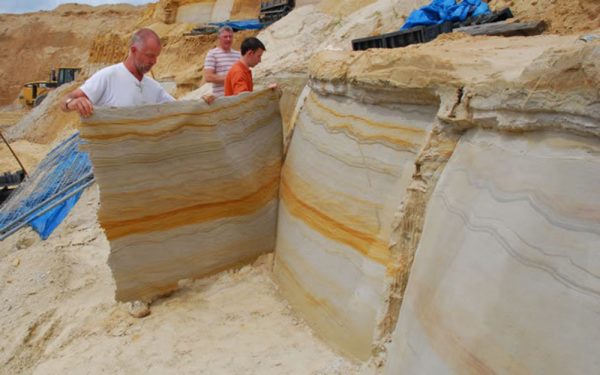
to contents ↑After partial hardening of the acrylic dispersion, the base is dried in the sun or in special furnaces. The stone layer makes the finished material durable, wear-resistant, fireproof, while it remains flexible. After cutting and packing, the flexible stone enters the stores.
Material scope
The stone is prepared on the basis of natural sandstone, therefore it acquires all the unique qualities of the latter - an intricate pattern and interesting texture, pleasant to the touch texture. In stores, it is presented to find more than 200 types of stone, differing in "appearance". Since the material is flexible, it can be laid on all surfaces with practically no shape restrictions: bending, curved, rounded, with corners, edges, etc. Such properties make the scope of use of flexible stone very extensive, it can be lined with:
- ovens;
- saunas;
- baths;
- pools;
- columns;
- beams;
- figurines;
- arched structures.
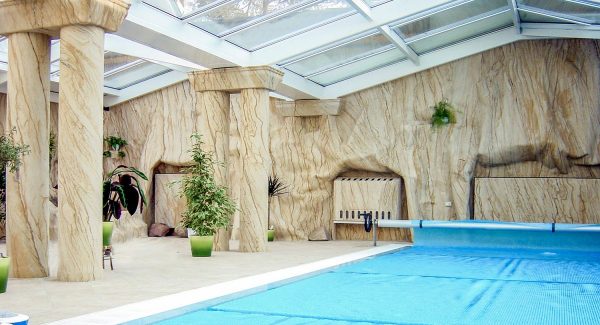
Window and doorways, bar counters and stairs are trimmed with flexible stone. It is suitable for wall cladding, both in whole or in part, in combination with other materials. The stone looks great in the interior of the bathroom, kitchen, is perfect for arranging a fireplace area with a real or electric fireplace. Decorative columns decorated with such a coating look luxurious and complement well the classic, antique or palace style.
With the help of a flexible stone, experienced craftsmen decorate murals, paintings that are exposed to UV printing from above. If desired, a lighting device can be made of such material, which, due to light transmission, will create a unique atmosphere in the bedroom and living room. The surface of the lamp, as it were, glows from the inside, all veins of sandstone stand out on it.
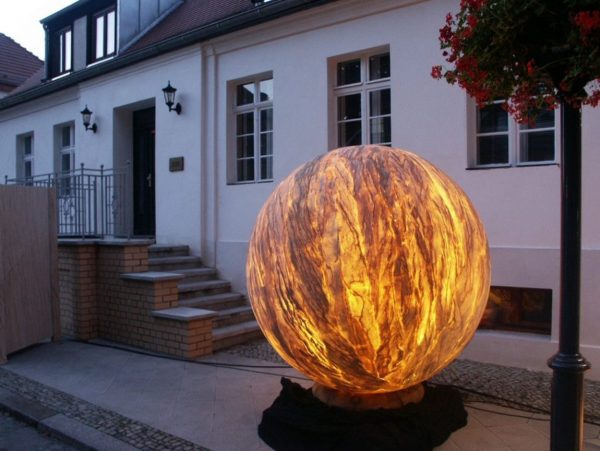
Special types of stone are widely used for exterior decoration of facades and other structures. Such products have a thicker layer of sandstone, therefore it is not damaged by the action of negative factors. Flexible material will be able to replace expensive natural stone, which is very difficult to use and has a high cost.
to contents ↑Advantages and disadvantages of the material
Flexible stone in the interior or for outdoor use has a lot of positive sides. Here are the main advantages of such a finish:
- Long service life. Most manufacturers of the material indicate a service life of at least 35 years, which is associated with wear resistance and the lack of response to temperature changes, the effect of atmospheric factors.
- Possibility of bending. The stone is easily rolled up. Due to its ductility, the material is conveniently glued to complex structures, as well as hiding all kinds of defects in the base.
- Resistance to damage. Like ordinary stone, a flexible material is difficult to scratch, it is not afraid of friction, wear, it can be washed, it is not destroyed by temperature shifts. Even with the appearance of a mechanical defect, a flexible stone can be restored.
- Resistance to physical factors. The material will not suffer from freezing, therefore it is suitable for unheated rooms, facades. He is not afraid of strong heating, and indeed it is fireproof, since it does not support combustion.
- Light weight (about 3-5 kg per 1 sq. M). Any sandstone-based coating, compared to natural stone or tile, will be quite light, it will not cause a serious load on the walls and other structures. Due to the low weight during installation, reinforcement and arrangement of additional fortifications are not required.
- Security. The finished material includes only environmentally friendly components, it has no toxins, organic solvents, harmful impurities.
- Easy to care. A flexible stone literally repels pollution and practically does not get dirty. If spots still appear on it, they can be washed off without problems with water or any detergents.
- Lightness of facing. The material can be cut with a knife, cut with scissors like wallpaper, cut out shapes of any complexity. Even a novice will be able to work with him, because he is firmly and quickly glued to concrete, wood, brick, gypsum board, fiberboard and repeats all the bends. In parallel, the material hides cracks, pits, chips and other imperfections.
- Monolithicity. The stone has a unique ability to give the walls the appearance of stone blocks, because the joints between the sheets become invisible after installation (subject to the technology).
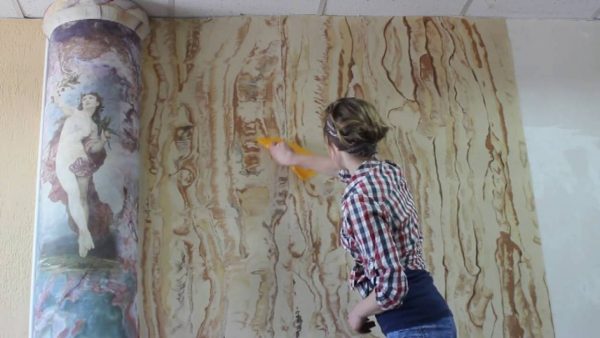
to contents ↑There are practically no disadvantages of this finishing coating. Its cost is lower than that of marble and other expensive varieties of natural stone, but still an order of magnitude higher than the price of tiles (1500-7000 rubles). High-precision equipment is used in the production, in addition, the technology includes a large amount of manual work, so a flexible stone simply can not be cheap.
Material Specifications
Flexible material is sold in the form of tiles or wallpapers of different sizes, so the user can easily choose the option that suits him. The main technical parameters of the stone are as follows:
- high weather resistance, climate resistance;
- significant UV stability and moisture resistance;
- water absorption - 1-6%;
- frost resistance - not less than 100 cycles;
- temperature range during operation - from –60 to +150 degrees, the optimum range is –40 ... + 70 degrees, short-term heating up to +600 degrees is allowed;
- combustibility class - G1 (low combustible);
- flammability class - B1 (hardly flammable);
- abrasion - 0.1-0.2 g / sq. cm;
- vapor permeability - 30-40 g / sq. m per day.
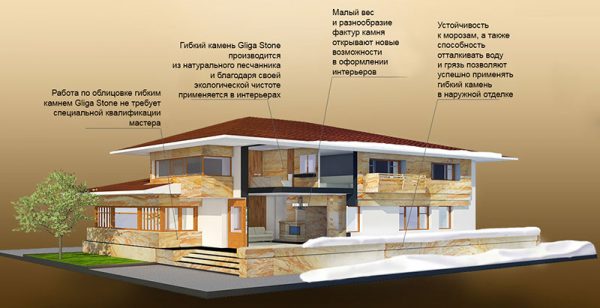
Features and operational characteristics of the material by type
Both tile and wallpaper made of flexible stone have approximately the same cost and technical characteristics, but differ in a number of parameters.
Flexible stone in the form of stone wallpaper
The rolling stone looks like a regular wallpaper 2-2.8 meters long. The thickness of the stone coating here is 1 mm, so the material is easily cut with ordinary scissors. It is ideal for wall cladding in the living room, bedroom, hallway and even in the bathroom, glued to adhesives containing PVA or other building mixtures. When applying wallpaper to angular and curved sections, you will need a building hair dryer, which will increase elasticity and evenly distribute the material along the base.
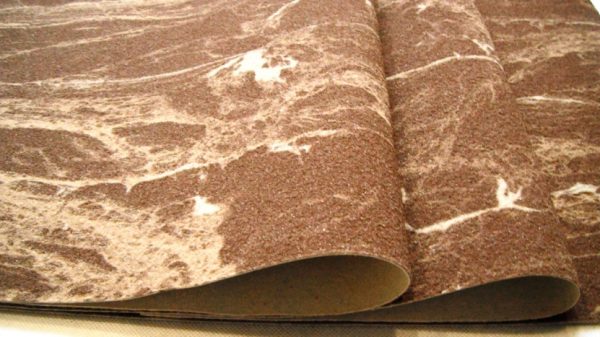
Tile flexible stone
Most often on sale there are tiles in the size of 80 * 40, 60 * 30, 20 * 30, 5 * 60 cm, but there are other options available. It is possible to produce custom-made finishes according to individual requirements. The thickness of the tile is 2-3 mm, so even the floor can be decorated with it. Work with this material does not differ from the installation of wallpaper, except that you have to more closely monitor the fitting of joints.
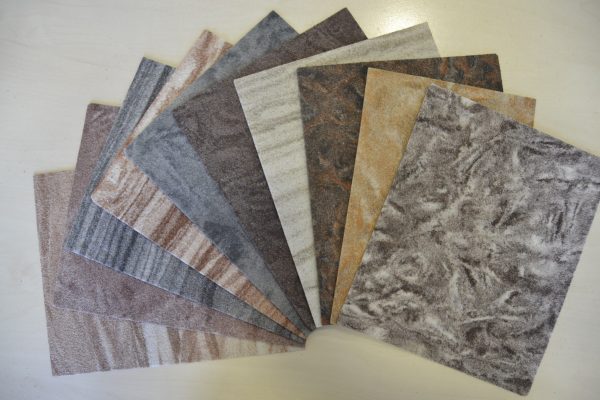
Flexible stone thermal panels
Such material is a tile of increased thickness, which is suitable for facing facades, baths, saunas, fireplaces. Thermal panels tolerate heating up to +650 degrees without damage to the coating or base.
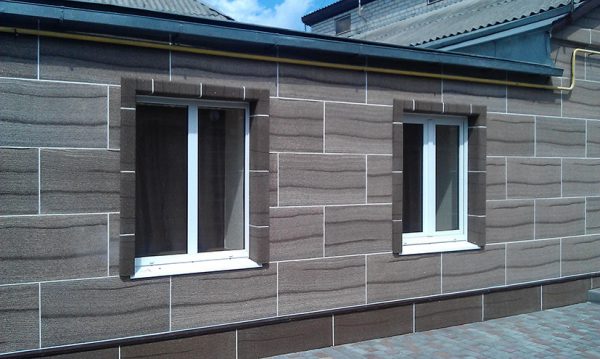
Features of manufacturing flexible stone
To make a stone with your own hands, you need sifted quartz sand of a fine fraction. If you have the financial ability, you can replace it with fine-grained marble chips. The list of other accessories for work is as follows:
- pigments for sand based on metal oxides;
- acrylic latex as a binder;
- polyethylene film;
- OSB-plate or plywood with 5 cm high bars nailed around the perimeter (it will serve as a drying tray);
- a large capacity for raw materials or several containers;
- tube with a funnel of glass, plastic, metal;
- glass sheet 1 * 1 m;
- Scotch.
First, sand must be mixed with dyes to get the right shade of raw materials. Further, the order of work will be as follows:
- apply latex on a plastic substrate with a layer of 3-5 mm;
- fix the plywood vertically, attach the substrate;
- to fix the glass from above, providing a "layer" between it and the adhesive base by means of bars;
- fix the glass with tape;
- through the top enter a tube with a funnel into the mold, start pouring colored sand, alternating shades and getting the desired pattern;
- let the latex dry, then disassemble the structure.
To speed up drying in the room, you can install powerful fans. If you immediately carry out work in several forms, the process of manufacturing a flexible stone will significantly accelerate.
to contents ↑Flexible stone mounting technology: features and nuances
To glue the stone, you will need a notched trowel, glue, a rubber roller, a brush, a hair dryer. The latter will help to avoid creases and cracks when bending tiles or wallpaper. The protective film from the stone is removed only after the completion of work on its installation. If you cover the glued material with a transparent protective varnish, the decorative surface will increase, and the service life will increase.
to contents ↑Foundation preparation
Thorough preparation of walls or other surfaces will enhance the degree of adhesion of the stone, as well as give greater accuracy when facing complex shapes, bends. All contaminants, grease, dust, traces of old paint should be removed if necessary, alignment and polishing of the walls.It is imperative to prime the base in 1-2 layers.
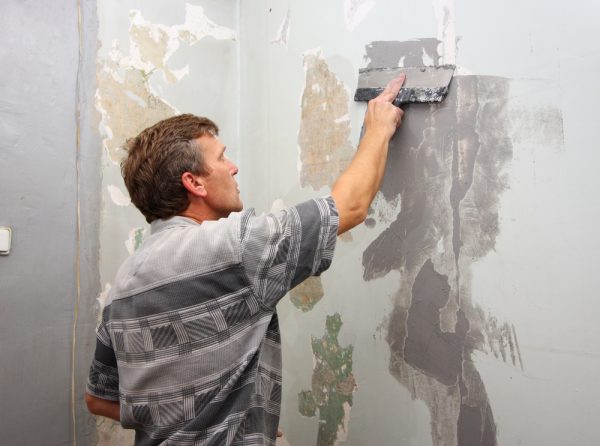
Selection and application of adhesive for flexible stone
For work, they select a moisture-proof colorless glue that is well suited for stone, or a tiled composition, universal acrylic glue. It is better to buy compositions of well-known brands - Knauf, Unis and others. You should not buy cheap low-grade mixtures - the service life of the finish with their use is seriously reduced.
Glues are sold in finished form or in the form of a dry mixture, which must be diluted with water according to the instructions. The tool is applied to the wall with a paint brush, and then smoothed out with a notched trowel with a fine pitch, which helps to increase its adhesive characteristics. On large bases, it is better to apply the adhesive with an even spatula, and then draw in the mass of the grooves with a gear tool.
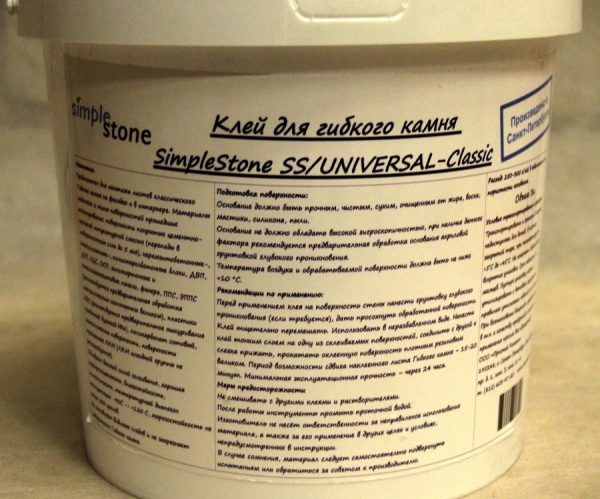
Installation of finishing material
Fixing tiles and wallpaper can be done butt or lap. In the first case, a seamless surface is obtained, so the method is preferred. During the installation process, a building hair dryer should be used, which helps to change the configuration of the plates and trim columns, arches, and other complex shapes with it. It is imperative that the angles are heated with a hairdryer, after which the material is wrapped and smoothed with a spatula.
Start laying the stone from the top corner. It is applied to the base, pressed tightly. The wallpaper is spread to the bottom point, rolled with a roller, the tile is joined with the next element. If grip needs to be improved, the flexible stone is carefully knocked down with a hammer.
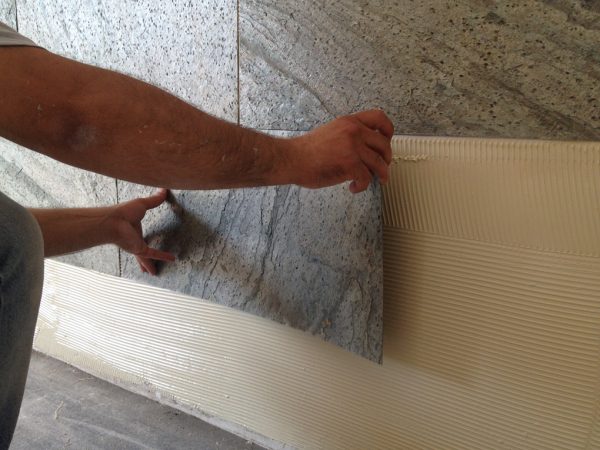
It happens that during installation small cracks appear in the material. They are easy to cover with colorless acrylic primer for mineral substrates. After complete drying, a special hydrophobic composition or varnish is applied to the finish with a wide brush.
to contents ↑Errors in the design of premises
If stone decoration is planned in a small apartment, it is important not to overload the interior with too many complex shapes, colorful details, otherwise it will cause eye strain. The color and texture of the stone should be carefully selected in accordance with other finishes, furniture.
Using different shades of stone, zoning of a room is often done, but in the future it can cause difficulties with replacing furniture and selecting accessories. When a stone is used to create frescoes and paintings, you need to work especially carefully: otherwise such a decor will look repulsive.
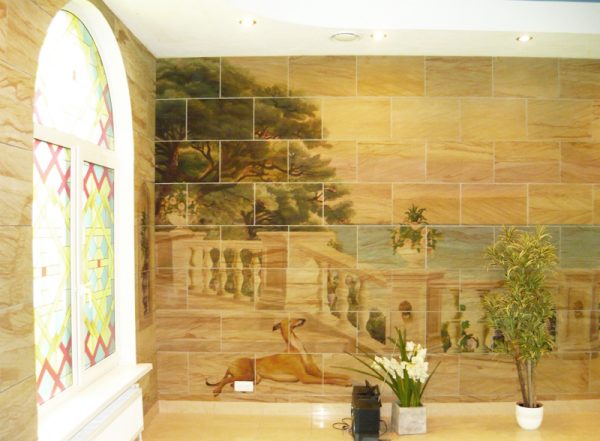
If you follow all the recommendations, a flexible stone will be an excellent alternative to the usual finish or will successfully harmonize with the "classics of the genre" - tiles, wallpaper, paint. It is quite possible to mount it with your own hands, which will save costs and allow you to get a unique finish with excellent technical characteristics!



